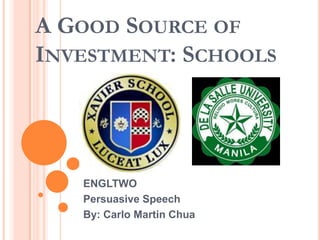Schools as good business
- 1. A GOOD SOURCE OF INVESTMENT: SCHOOLS ENGLTWO Persuasive Speech By: Carlo Martin Chua
- 3. THESIS STATEMENT ÔÇ¢ Even if most people prefer other businesses such as franchising, buy and sell, importing goods, the best way to earn money with a large capital is through putting up schools since they provide steady income due to the need of education and the number of people in an area.
- 4. ADVANTAGES OF SETTING UP SCHOOLS ÔÇ¢90% of the current educational institutions within the country are privately owned compared to the other 10% that is under the government (Tirona, 2006)
- 5. ADVANTAGES OF SETTING UP SCHOOLS ÔÇ¢Lucio Tan himself owns a privately owned school which is the University of the East("Lucio C. Tan Group of Companies", 2009)
- 6. ADVANTAGES OF SCHOOLS  According to 1988 Philippine government figures, which count as literate everyone who has completed four years of elementary school, the overall literacy rate was 88 percent, up from 82.6 percent in 1970. Literacy rates were virtually the same for women and men. Elementary education was free and, in the 1987 academic year, was provided to some 15 million schoolchildren, 96.4 percent of the age-group. High school enrollment rates were approximately 56 percent nationwide but were somewhat lower on Mindanao and in Eastern Visayas region. Enrollment in institutions of higher learning exceeded 1.6 million (1991).”
- 7. STEADY INCOME TO INVESTORS ÔÇ¢ Education has been consistently in-demand ever since it was first introduced to the world that is why putting up schools which provide quality education will never cease to exist. The proportion of the national government budget going to education has varied from a high of 31.53 percent in 1957 to a low of 7.61 percent in 1981. It stood at 15.5 percent in 1987. The peso amount, however, has steadily increased, and the lower percentage reflects the effect of a larger total government budget (Dolan, 1991).
- 8. STEADY INCOME TO INVESTORS ÔÇ¢ This kind of business provides steady income to its investors since the school gets a nice big influx of cash before the course has started. Many schools find this means they can make capital improvements that they have never managed to before, like equipping the whole school with what the students need such as equipment (Case, 2008).
- 9. VISUALIZATION A. The school would be a success and produce a substantial amount of profit. B. Help increase the quality of education in the country. C. Produce graduates that can eventually aid the nation's economic status. D. Increase literacy rate in the Philippines
- 10. ACTION A. Start saving up money or ask for a loan from the bank. B. Collaborate with those who are also interested in this type of investment and plan ahead. C. Coordinate with the necessary groups, corporations or persons that are needed in this sort of venture. (Construction, Furnitures, Utilities, Staffs) D. Push through the plan and initiate the school’s structure and open to the public.
- 11. REFERENCES Case, A. (2008). Setting up a TEFL Certificate Course: Advantages & Disadvantages Retrieved March 20, 2012 from http://www.usingenglish.com/teachers/articles/setting- up-tefl-certificate-course-advantages- disadvantages.html Dolan, R. (1991). Philippines: A Country Study. Retrieved March 20, 2012 from http://countrystudies.us/philippines/53.htm Meinardus, R. (2003). The Crisis of Public Education in the Philippines. Retrieved March 20, 2012 from http://www.fnf.org.ph/liberalopinion/crisis-public- education-philippines.htm
- 12. REFERENCES Lucio C. Tan Group of Companies (2009). Retrieved March 22, 2012 from http://www.ltgroupphils.com/ Tirona, G. (2006). A Global Guide to Management Education Retrieved March 26, 2012 from http://www.gfme.org/global_guide/pdf/177- 182%20Philippines.pdf











